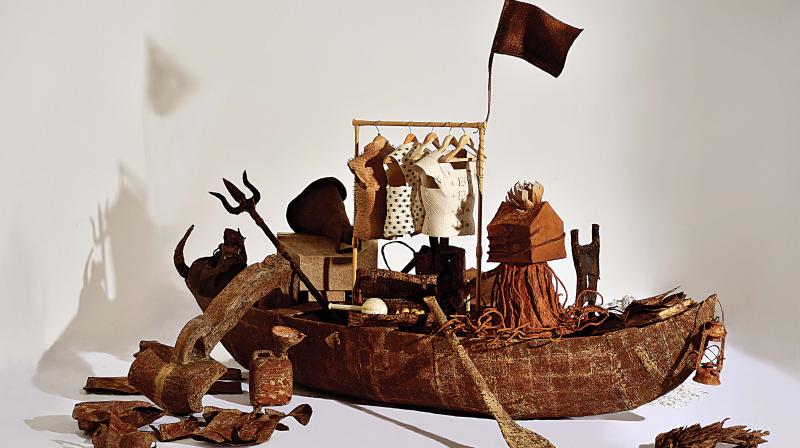Art and the meaning of life

What: Silent Echo
When: Nov. 28 to Dec. 31
Where: Gallery Sumukha, Wilson Garden
The Old Man and the Sea," was the first reference to spring to mind, as a large, cluttered boat, the titular piece of Ravi Kashi's latest solo exhibition, Silent Echo, arrests one’s gaze. The smile that broke out across his face led me to believe that I had somehow caught on to an underlying idea, the shining silver thread connecting the array of objects that comprise the exhibition.
As Kashi, who surrendered his usual taciturn manner for a few moments of candour, walked me through the show, it was evident that “array of objects” is a gross underestimation of his extraordinary, poetic process. “Nothing works in isolation,” he remarked. “Everything in the world echoes with everything else. An object takes on its own life and new meaning based on the person who possesses or observes it.”
It is this near-preoccupation with the pursuit of meaning in unexpected places that has Kashi trawling through second-hand markets and rummaging through things his friends and relatives would otherwise have thrown away. “They call me now, to tell me they have a bunch of things they don't need anymore,” he laughed.
Kashi explores, through five, seemingly unrelated pieces of work, how objects become an extension of the human experience. “They have a memory and gain their own persona over a period of time,” Kashi explained. Memorial 1 and 2, for instance, depict showcases, that cynosure of most Indian homes. "You can learn a lot about people based on what they keep in their showcases,” Kashi smiled. Interestingly, the objects have all been wrapped, which he says is for uniformity. “This way, there is no hierarchy, which I like. Also, you don't know which object is precious and which is not. It is an act of discovery.”
Myriad Indecisions intrigued me too, with the sculpture of an open book upon which the word “Forever” is engraved. Letters of the alphabet lie scattered around it. “Language is infinite, we can create from it anything we wish. Once a thought has been written down, however, you're capturing it and putting it in a box.” This thought is Kashi's response to a world where information is delivered to us in capsules, conditioning every aspect of our lives.
Kashi stops to point out a tiny spiral staircase, placed in a glass box that opens out onto a decidedly disturbing black house. “We all dream the same dreams,” he said. “We're told we should aspire toward a house of our own, that is the first step. Even so, the darkness is there, it always will be.” We moved on from there to Heirlooms of Fear - glass cases propped up on two piles of newspaper. “Notice the newspapers?” Kashi asked. “That represents the media, which propagates fear,” he explained patiently.
He draws greatly from the outside world, retreating then into the universe within, to contemplate. “Art is about introspection,” Kashi said. “It is a search for meaning. I'm very aware of what happens around me and to be fair, my perception contains a thread of irony, although there is a lot less vitriol in it now. The visual medium, I have learned, requires a great deal of restraint.”
Every detail, he said, contains clues to much larger questions. Discussing every object means a lengthy discussion (one we chose to have), but one does come away with a single, heightened sense of understanding. As Kashi remarked, “We live in a world where there is an absence of filters. We are bombarded by images and ideas, left with very little time to look within. The dialogue is entirely black and white, so what happens to the grey? Where does that leave those of us who refuse to be put in a box?”

